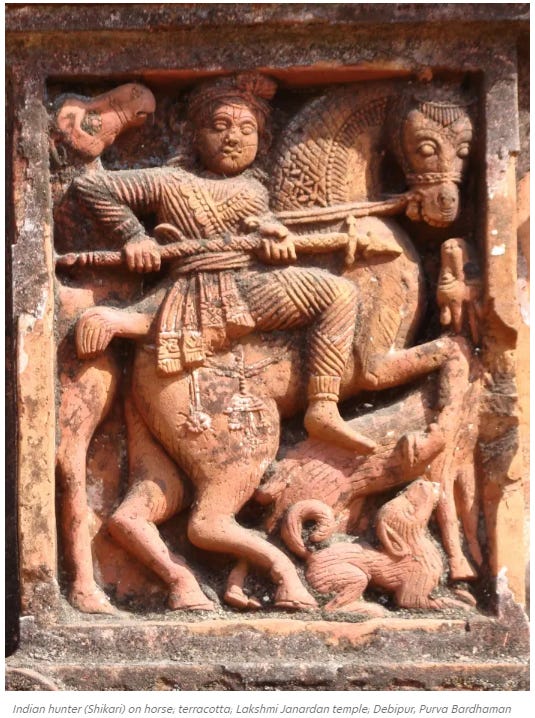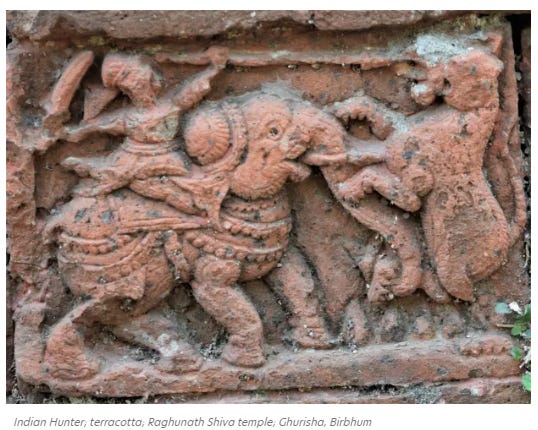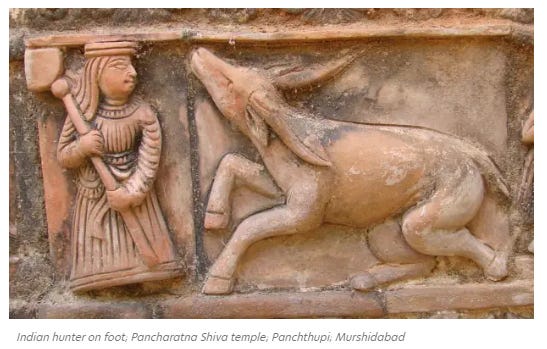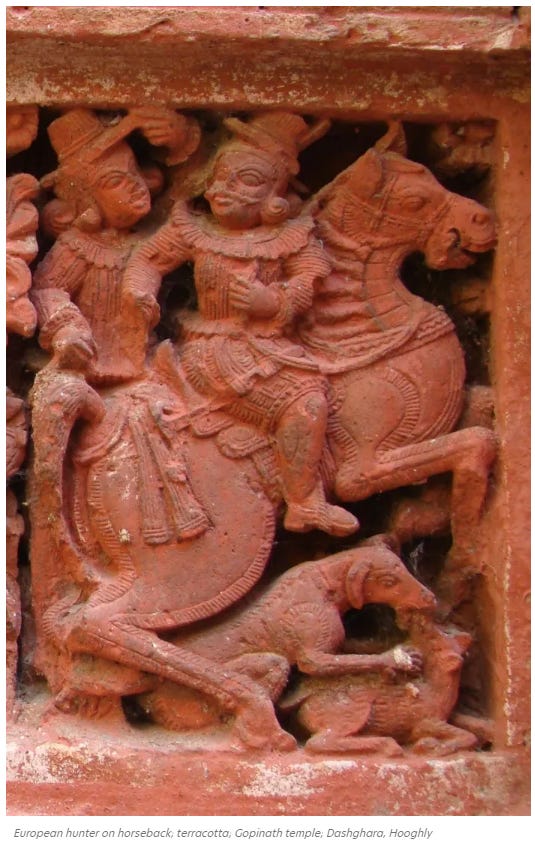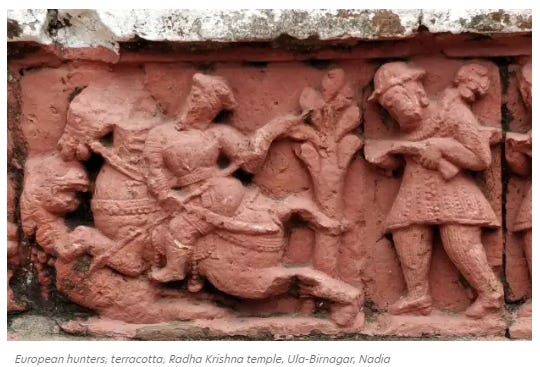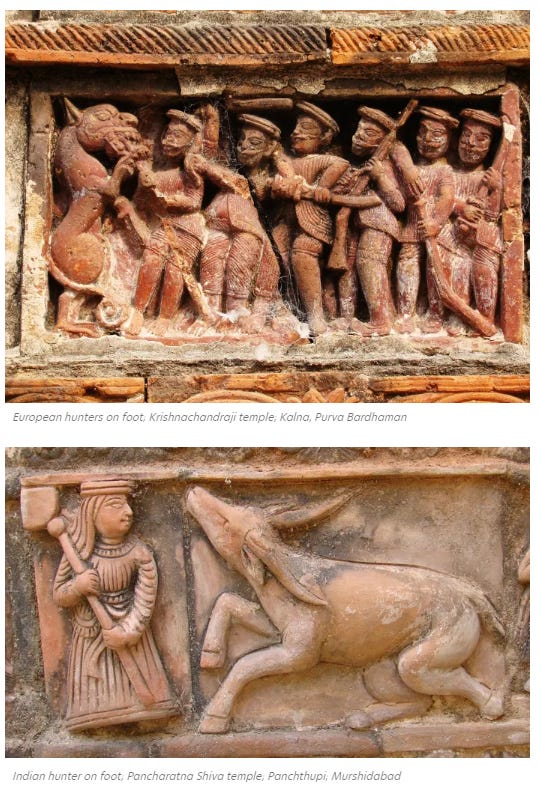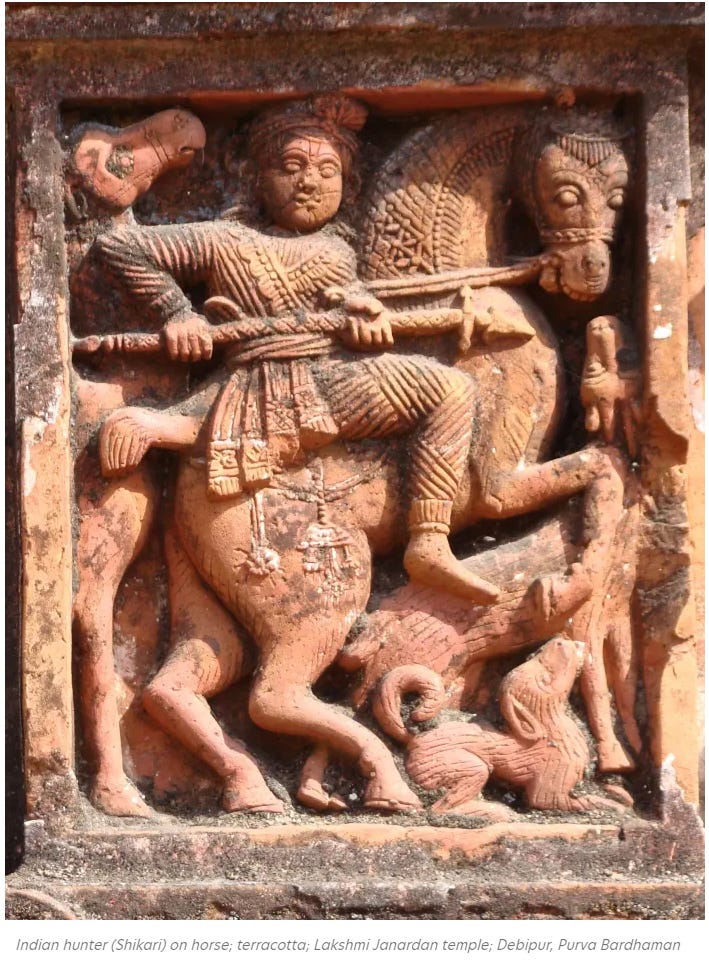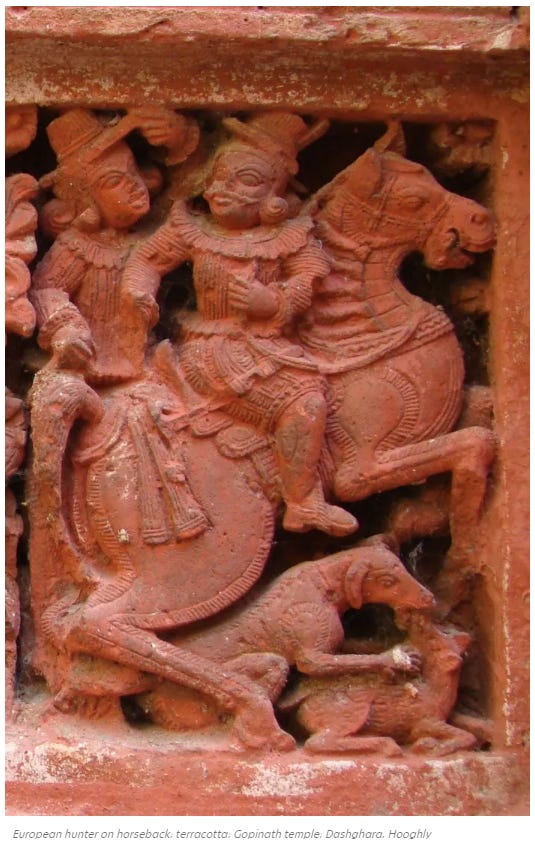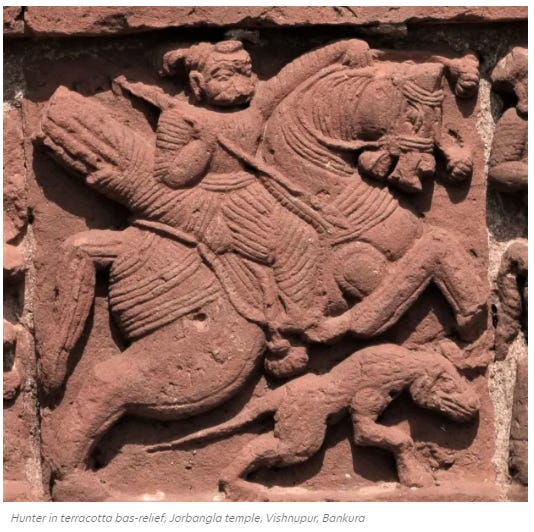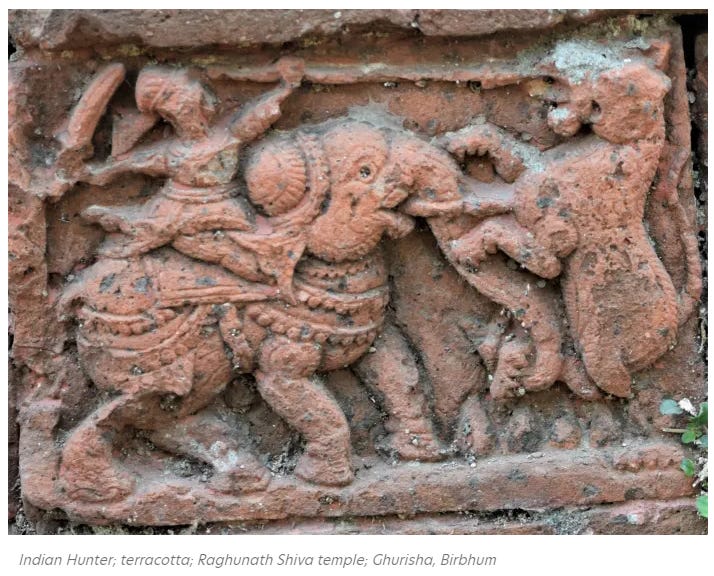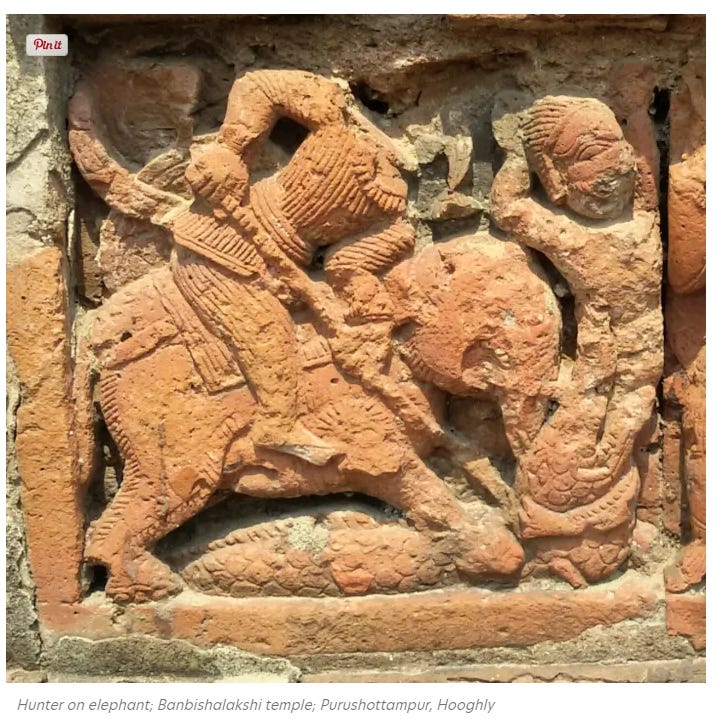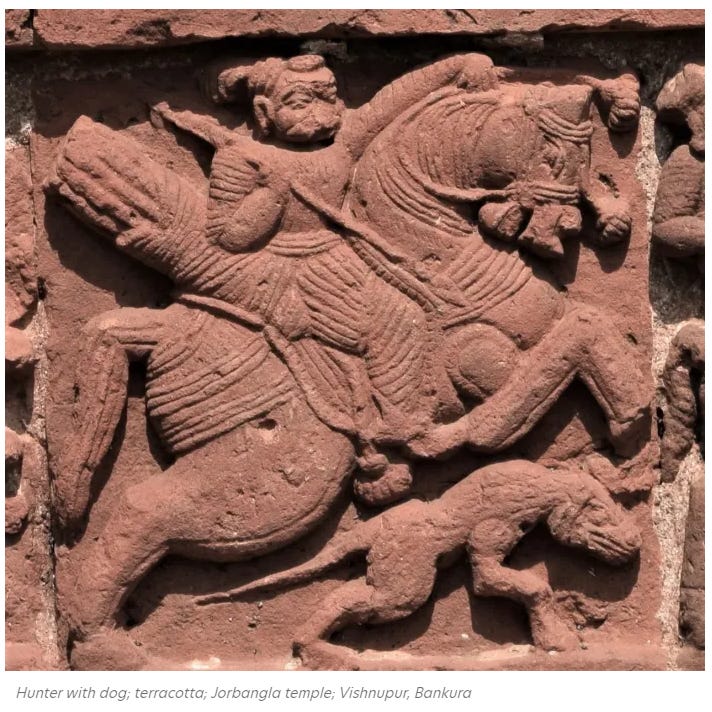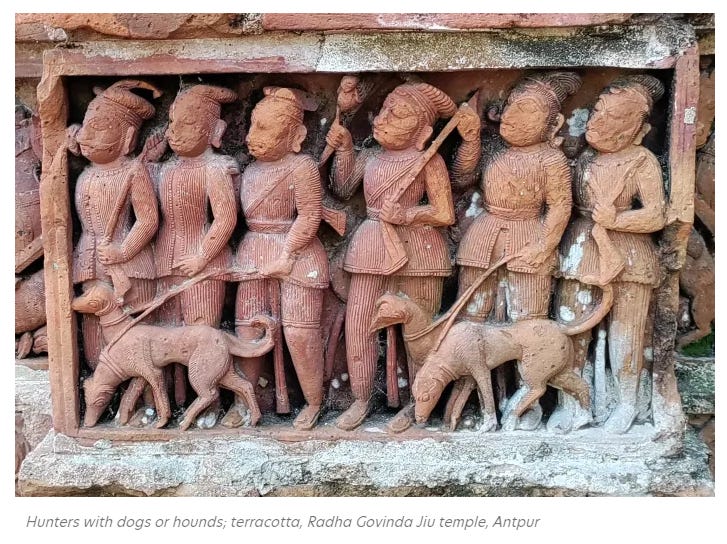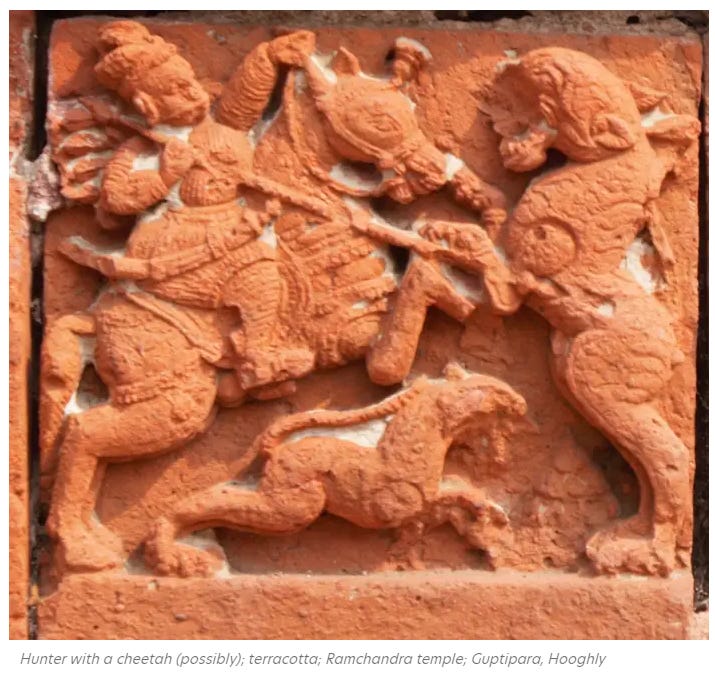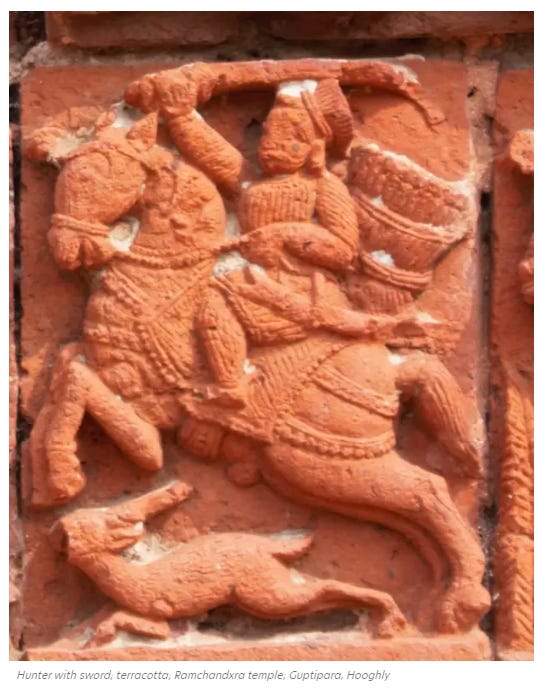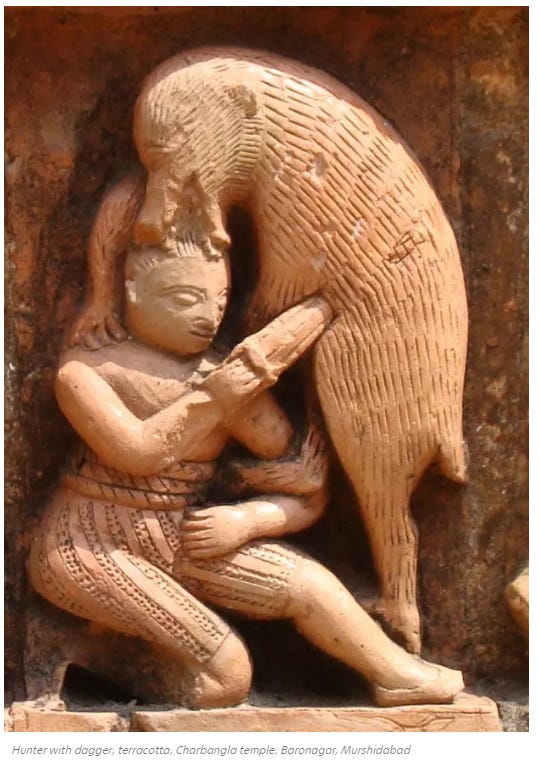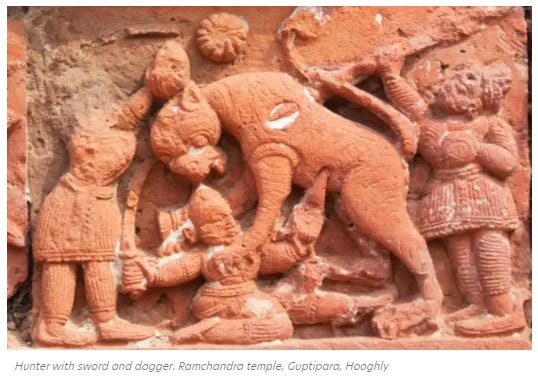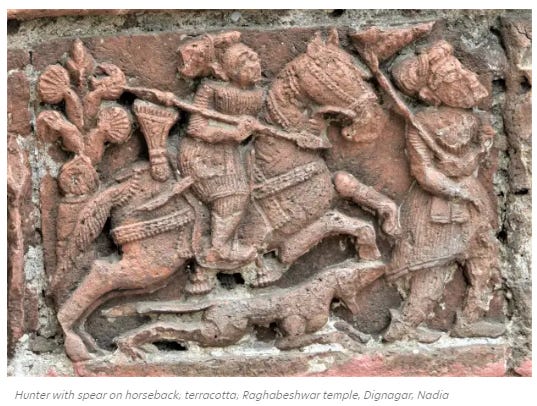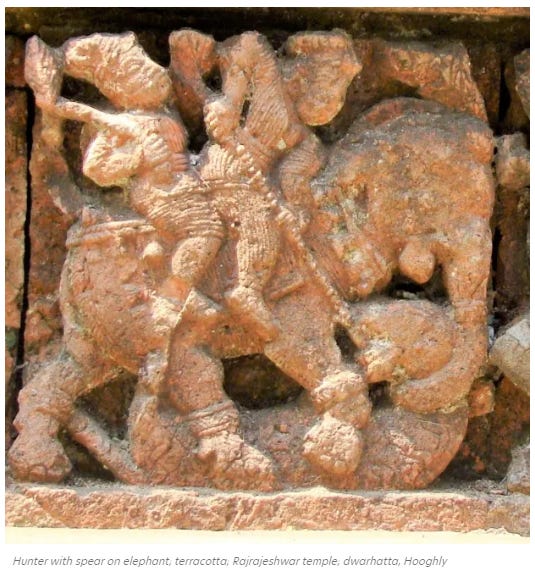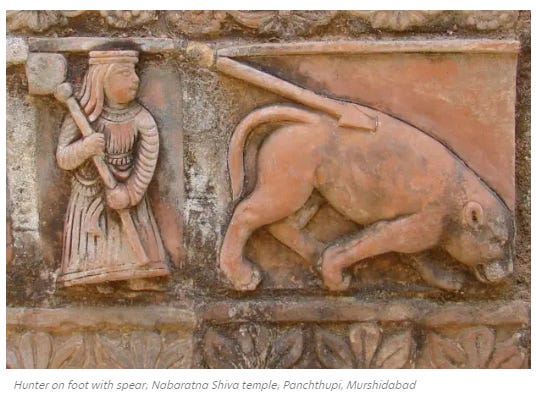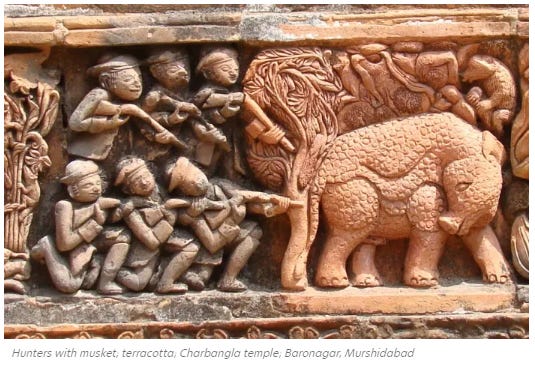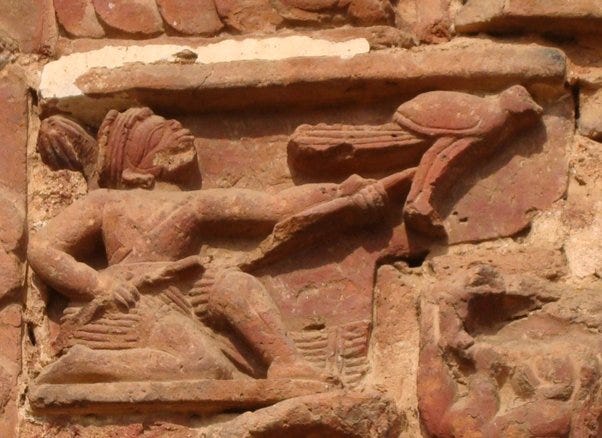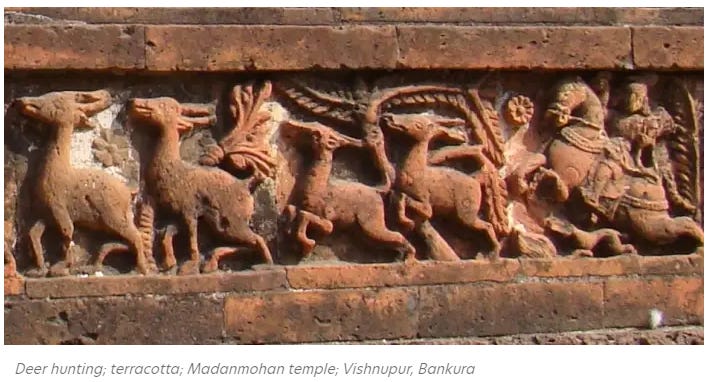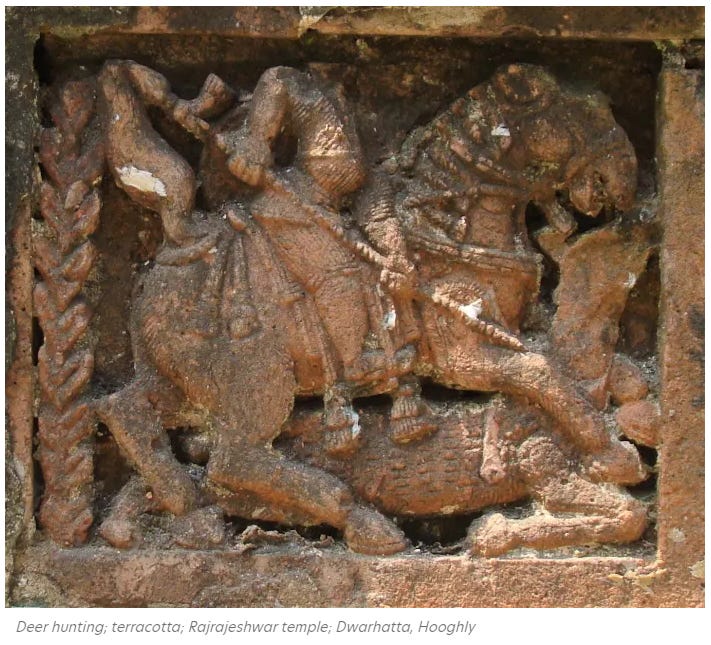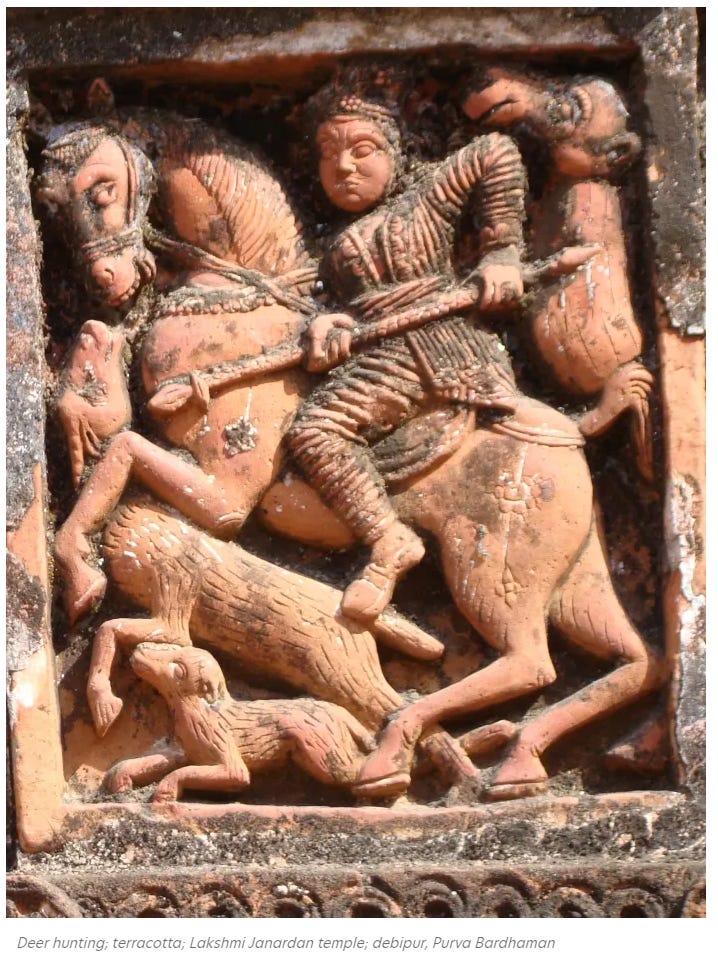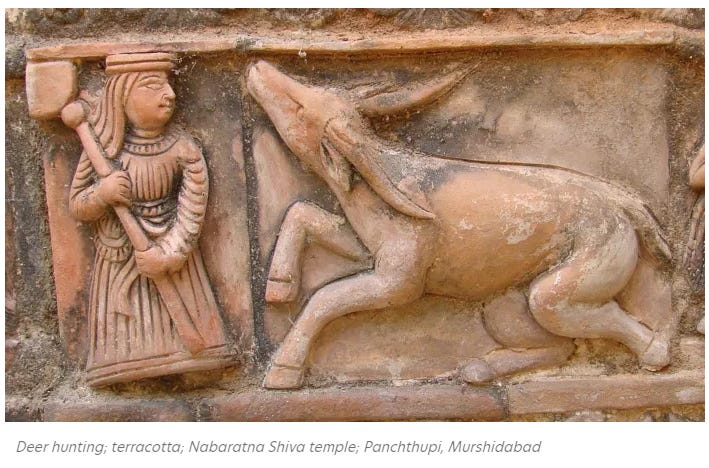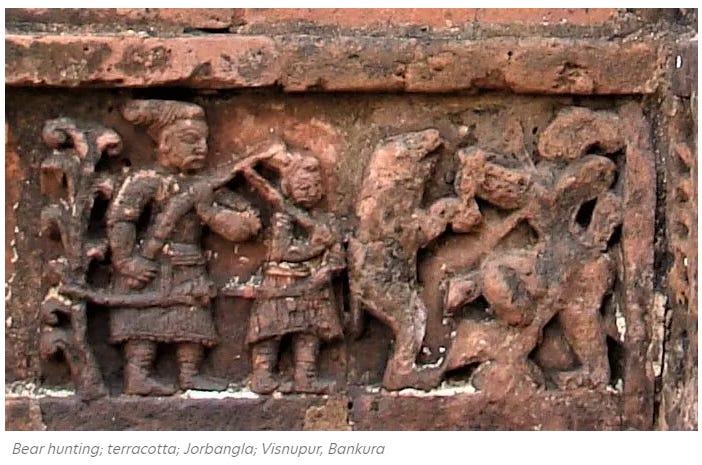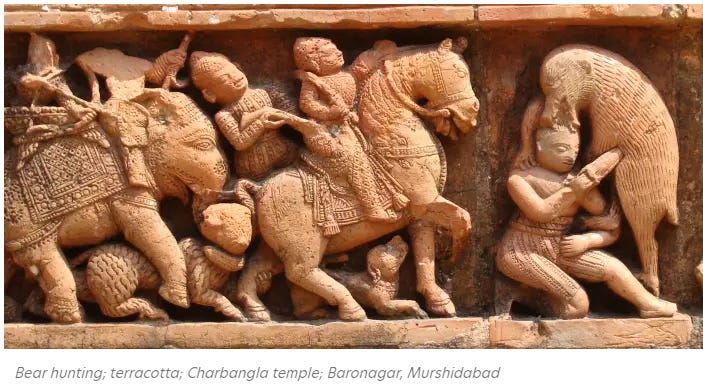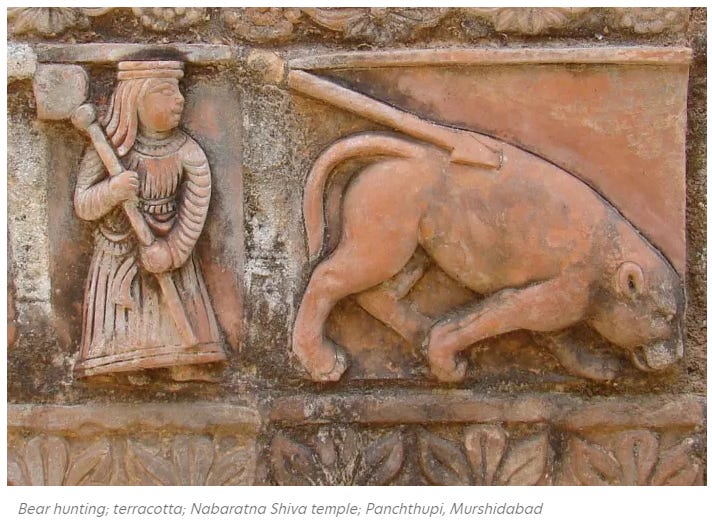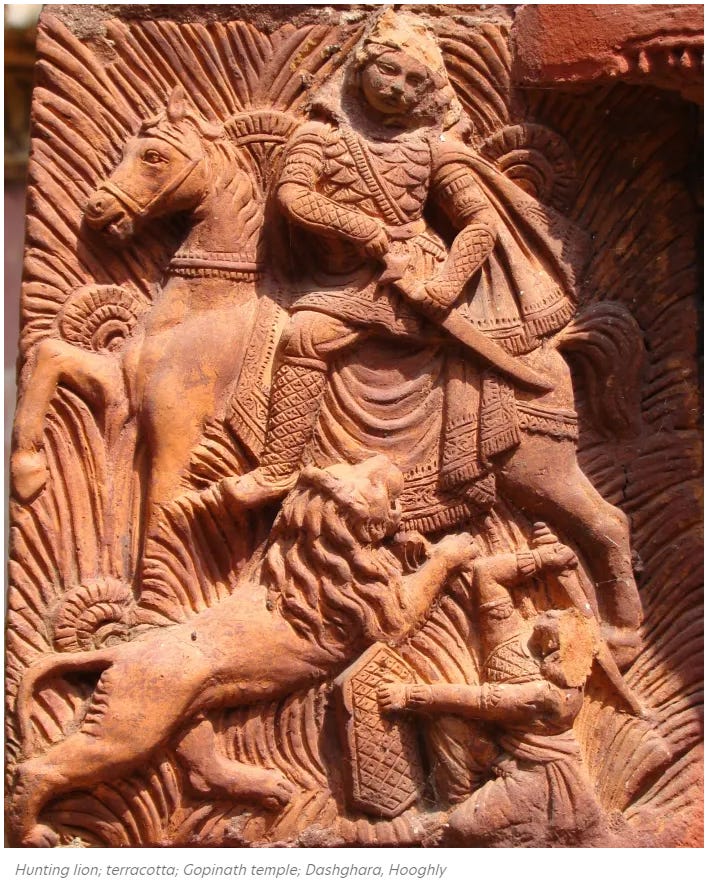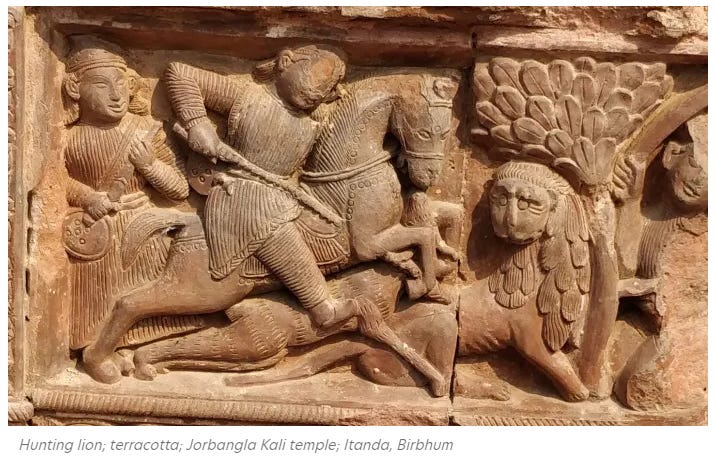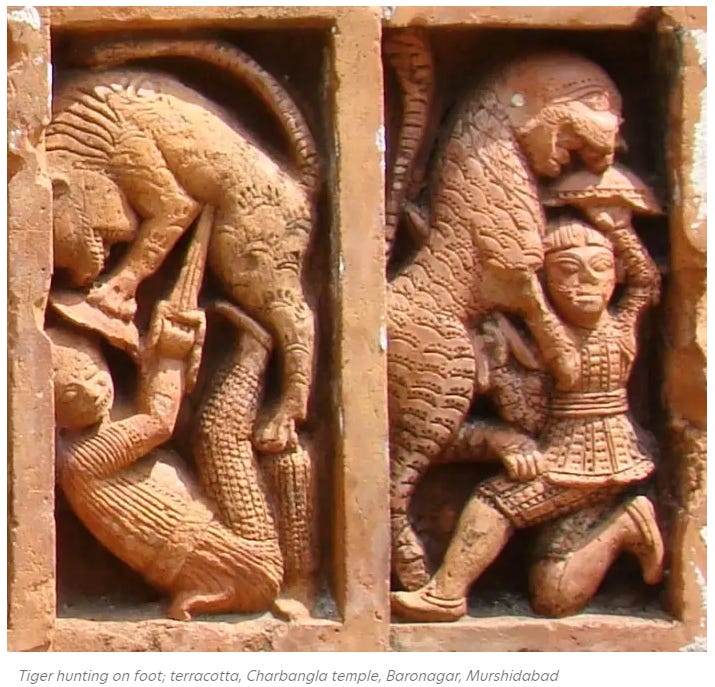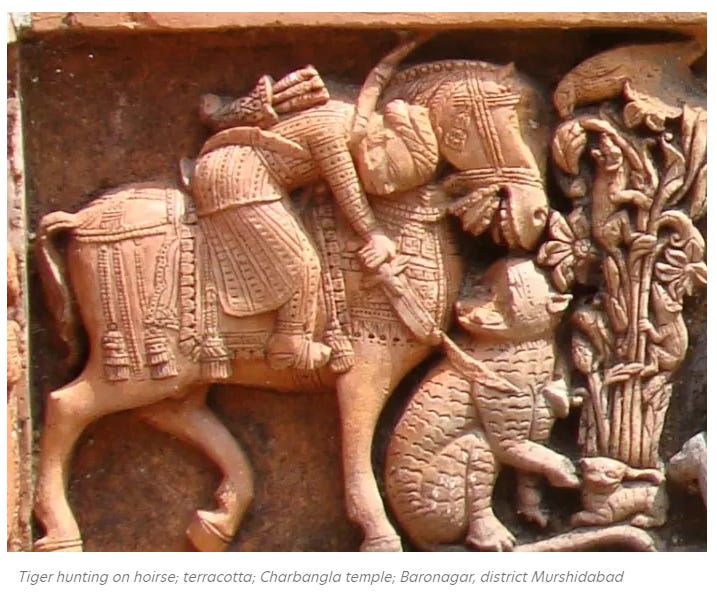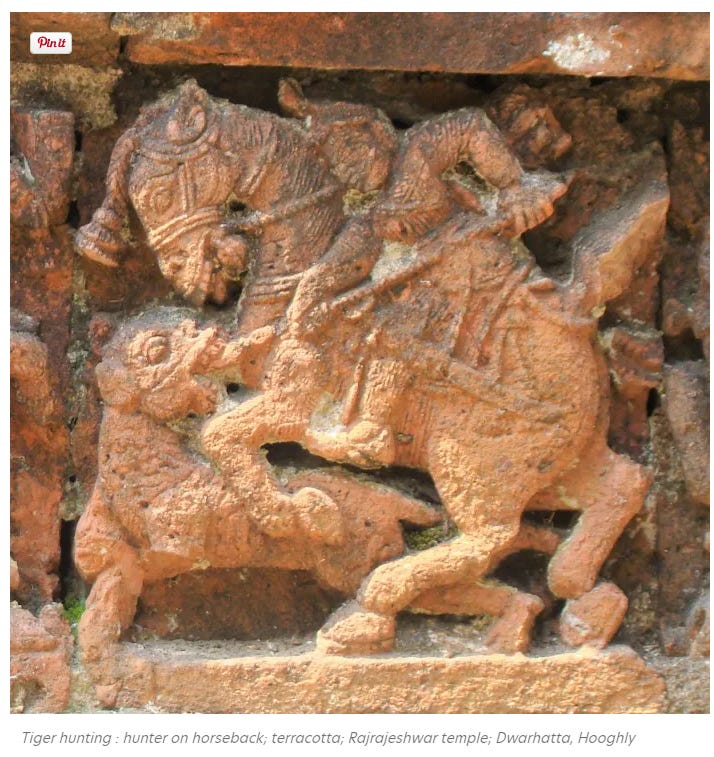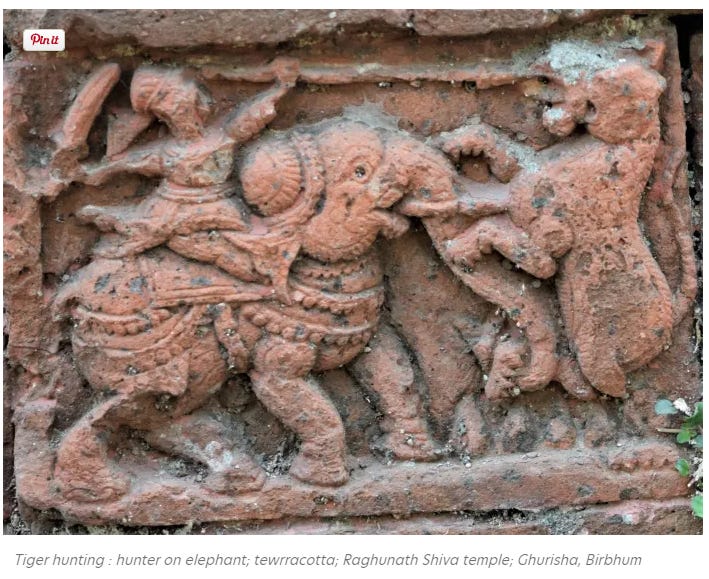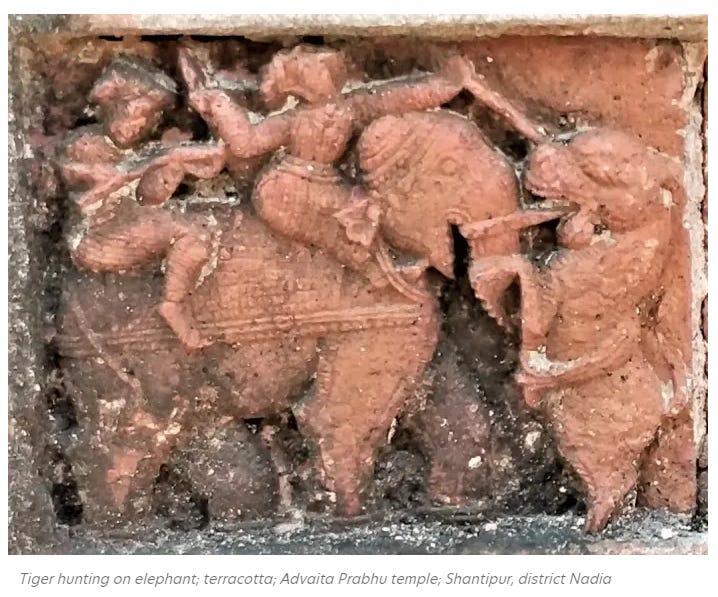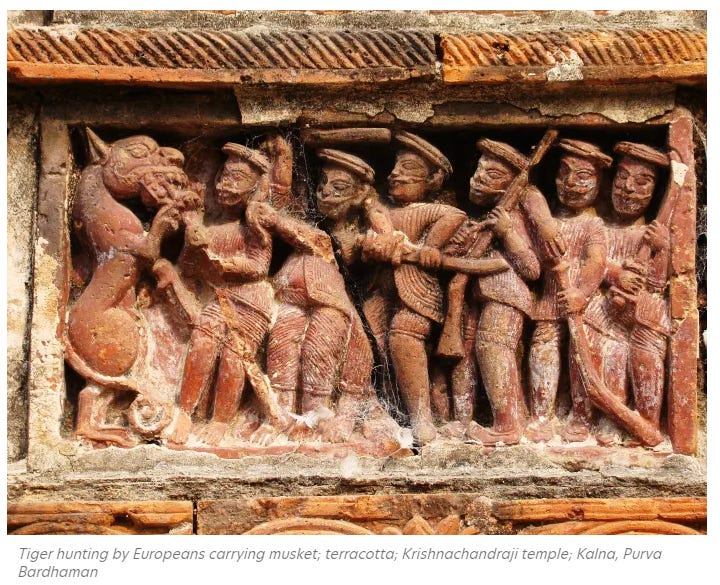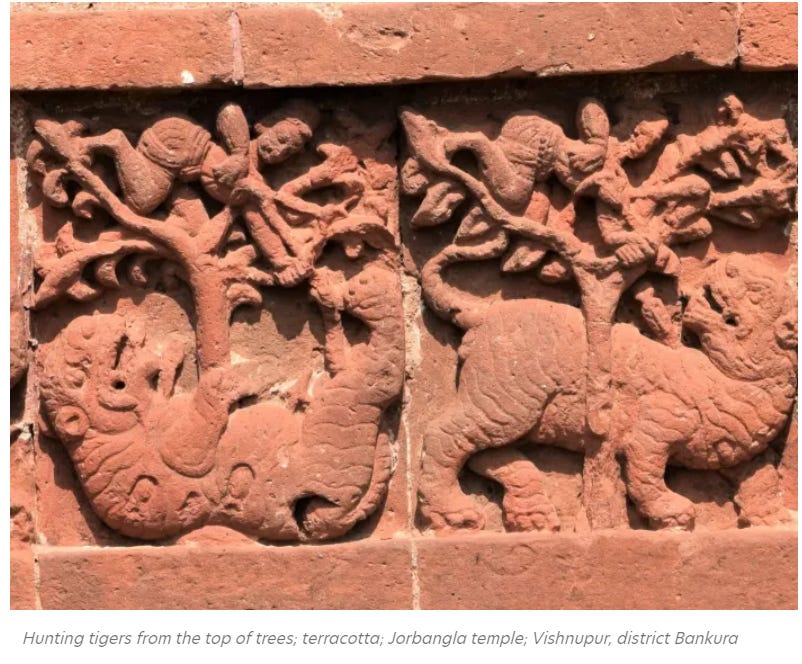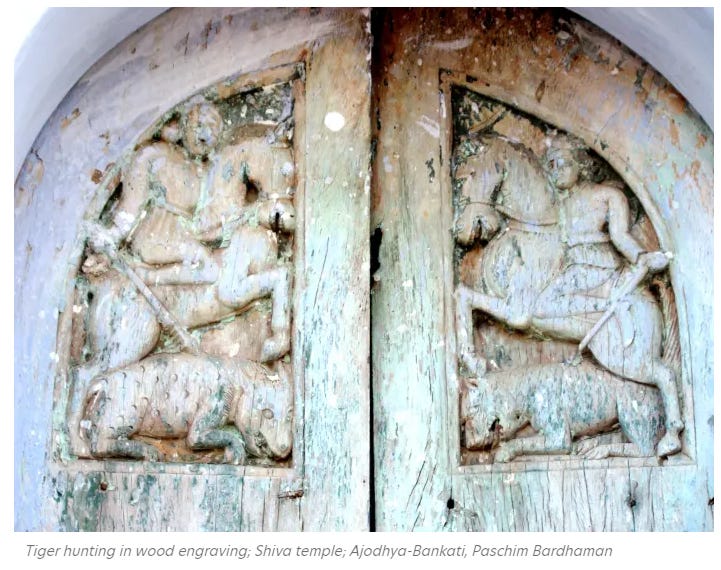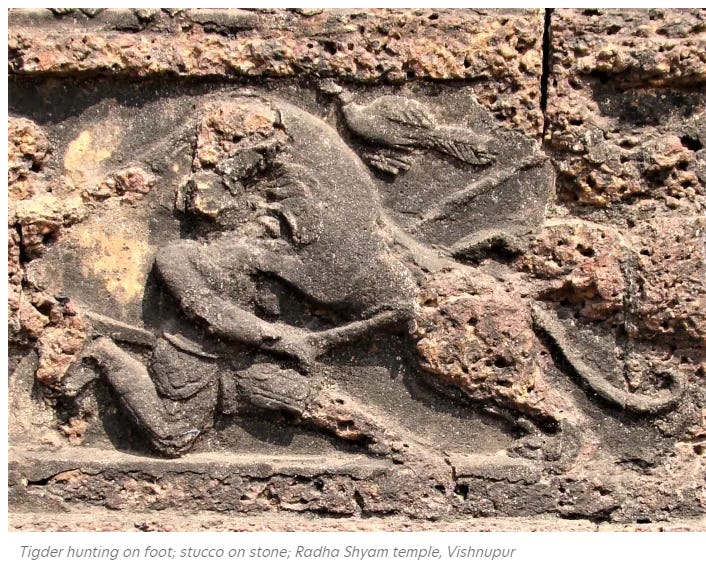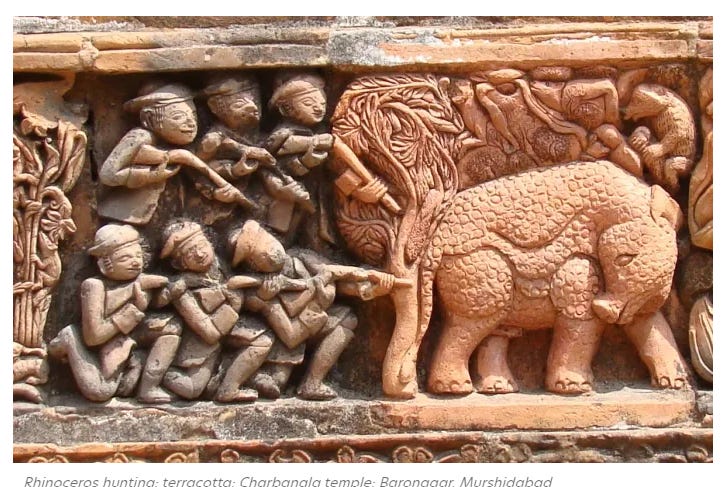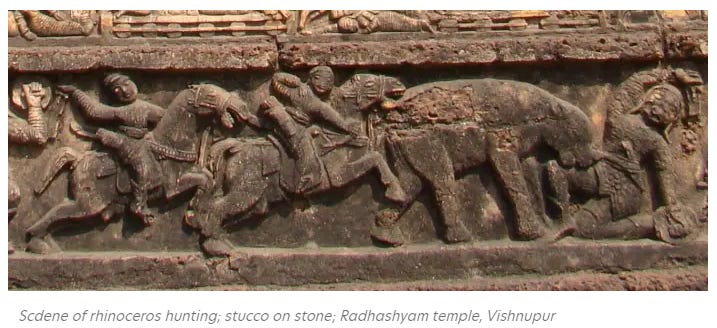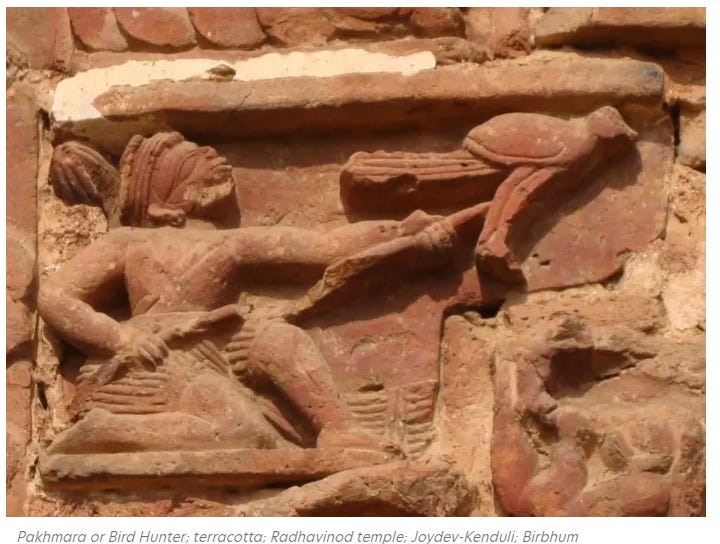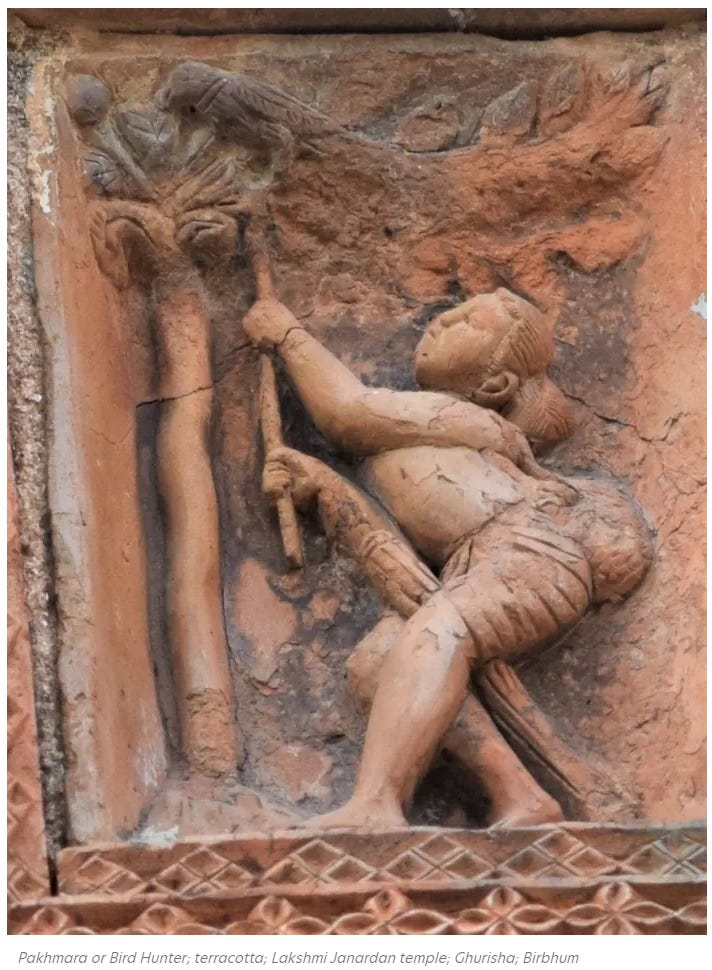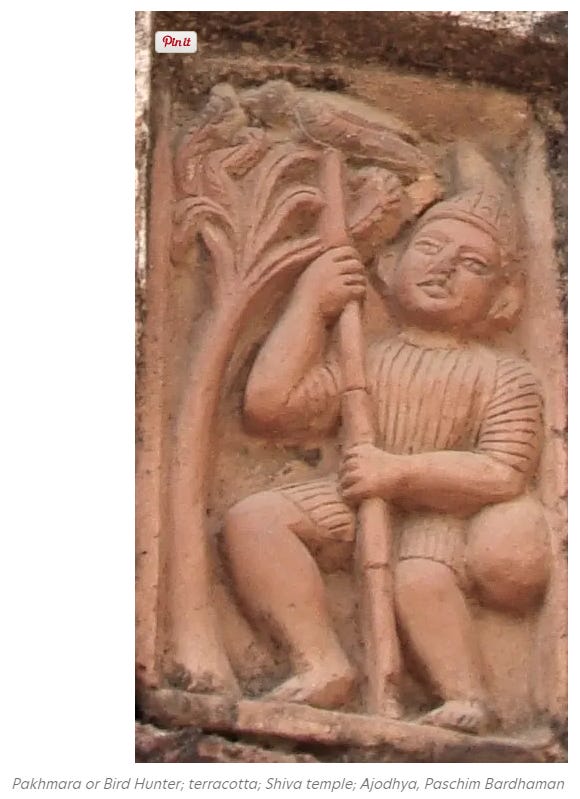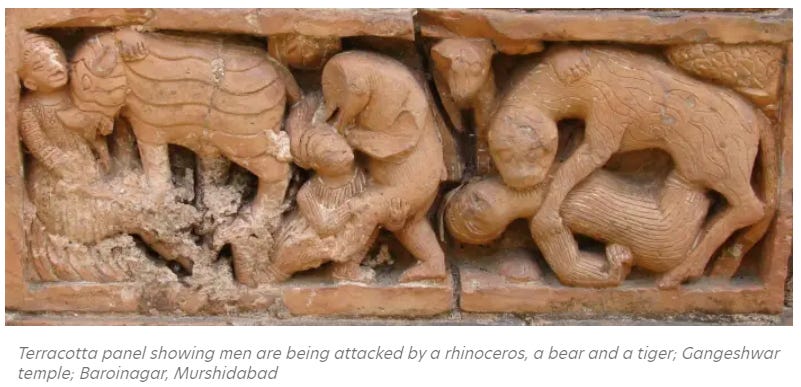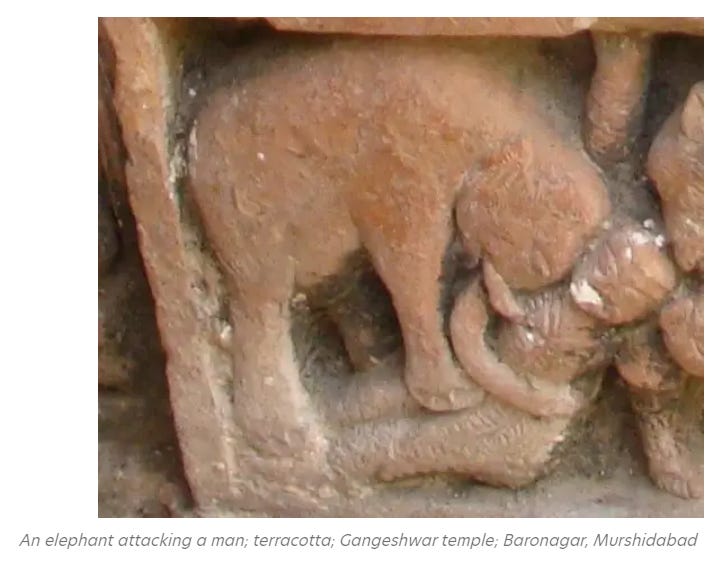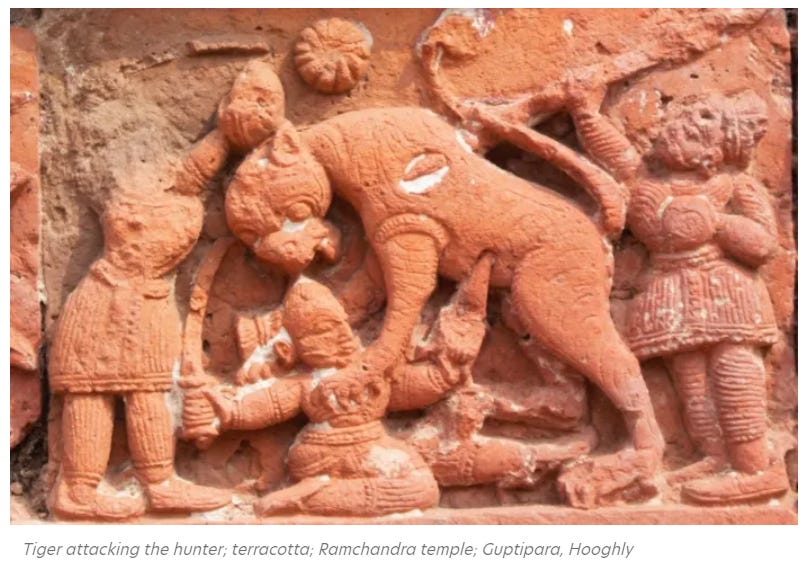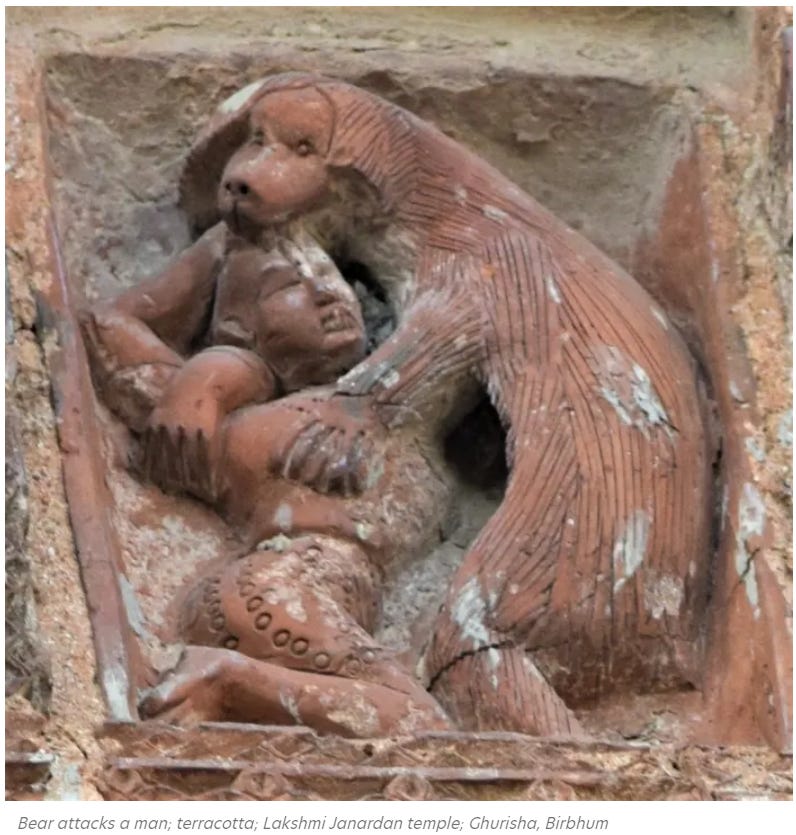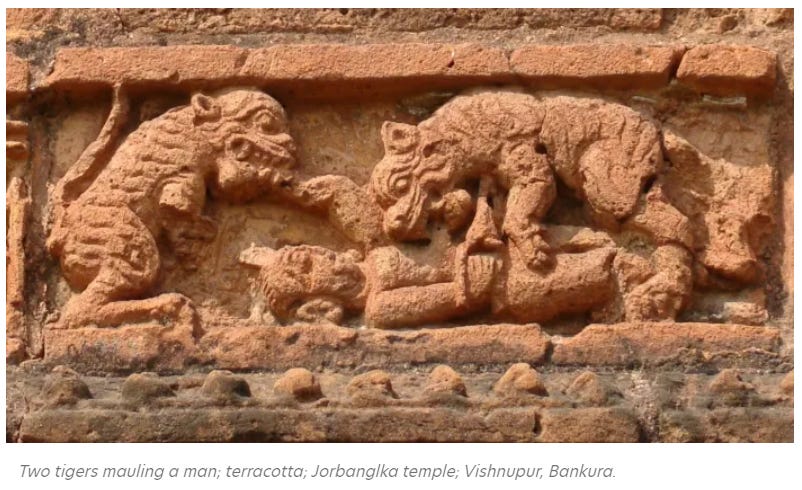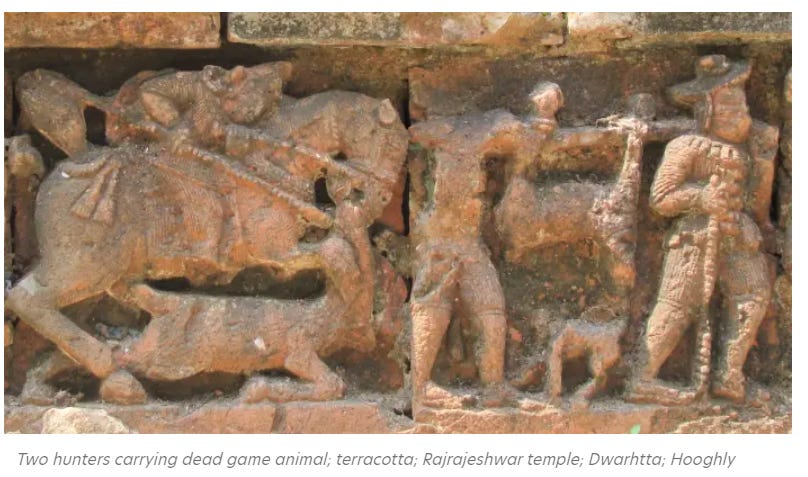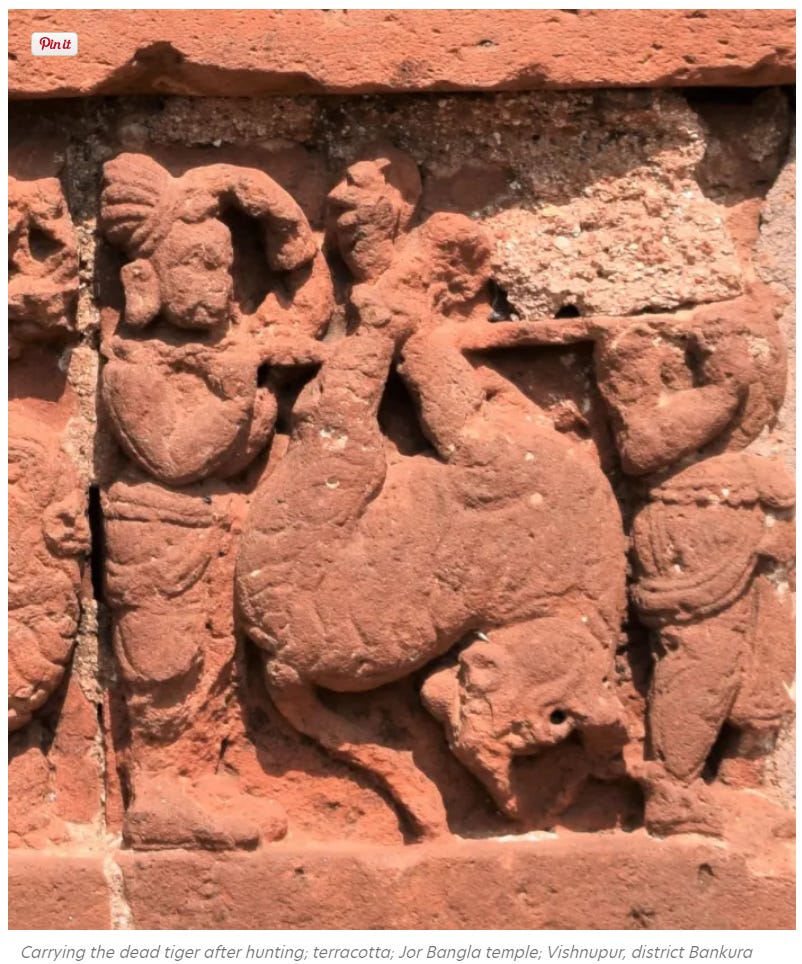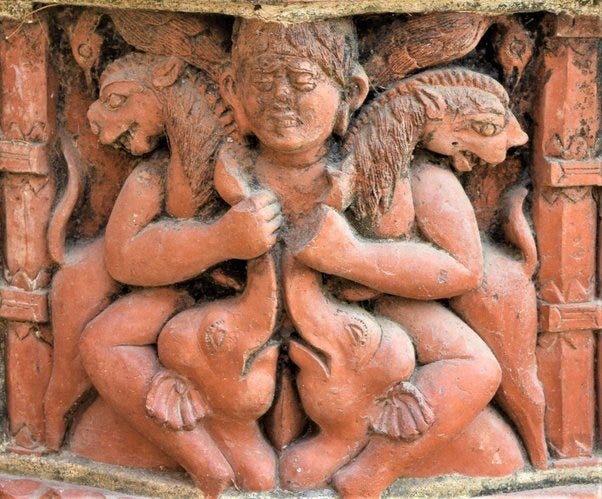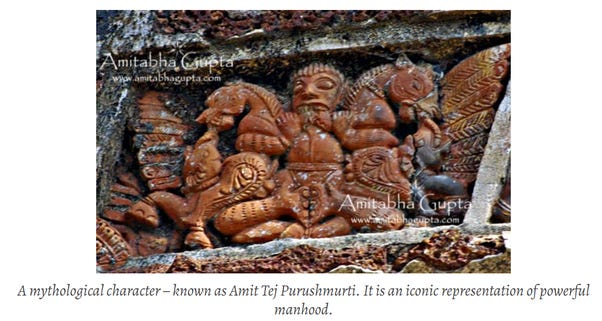Temple Architecture Decorative Elements: Bāṅlā Temple Architecture Decorations - Hunters and Hunting scenes
Introduction
As the temples in Bāṅlā region were constructed by the local landlords & rich merchants, and as it was fashionable to be involved in hunting, it was inevitable that the artists would be encouraged to put hunting scenes in the temple art, either directly by the patrons paying for it, or by the fact that it was an attractive subject for their work. For this reason, the medieval temples in Bāṅlā region have a rich collection of hunting scenes, mostly in terracotta, but also in other medium like stucco, stone and painting.
In form of temple art, these scenes capture ecological destruction and the loss of biodiversity in Bāṅlā region.
Quoting from https://discover.hubpages.com/art/HUNTERS-AND-HUNTING-IN-THE-DECORATIONS-OF-TEMPLES-OF-WEST-BENGAL (with ISO 15919 transliterations and some additional context added)
Hunting was an honorable activity in India from the very early period, as evident by the fact that gods & mythological figures are described to be engaged in hunting. Lord Śiva, one of the Trinities of Hinduism (here referring strictly to Sanatanism rather than the legal term encompassing many other religions), has a name Mr̥gavyādha meaning “deer hunter”, thus glorifying the act of hunting. The Kings & princes of the two great Hindu epics Rāmāyaṇ & Mahābhārata were also described as expert hunters.
Later, during the feudal and colonial times hunting was regarded as a regal sport in India, & the kings & princes were involved in hunting in a big way. Gurkani (Mughal) emperors were avid hunters. It is said that firearms were introduced in hunting scenario in India during the reign of Gurkani emperor Akbar I (1556 - 1605 CE).
There were professional hunters in their pay roll called Śikārīs. The tradition was continued in the British period as the British loved & encouraged hunting.
All hunting in India is prohibited now under Wild Life Protection Act 1972.
Medium of art
The vast majority of the pictures used for temple decorations in Bāṅlā region is Bas-relief of terracotta plaques, but other media like stucco, stone-work and wood-carving are also seen.
→ L2R: Examples of Hunting scenes by medium [Source: Hunters and Hunting in the Decorations of Temples of West Bengal]
Hunter in terracotta bas-relief; Jorbangla temple in Bishnupur, Bankura, West Bengal, India
Hunting scene; stone carving; Shiva temple in Ganpur, Birbhum, West Bengal, India
Tiger hunters; carving on wooden door; Shiva temple in Bankati-Ajodhya, Paschim Bardhaman, West Bengal, India
Details of Hunters
Nationality/Ethnicity of Hunters
Though the vast majority of hunters depicted in hunting scenes in the temples are native Indians, there are some European hunters too — examples of the latter can be seen in Gopinath temple of Dashghara in Hooghly district, Radhakrishna temple of Ula-Birnagar in Nadia district and Krishnachandraji temple of Kalna in Purba Bardhaman district.
→ Indian Hunters examples:
Horse-mounted Indian hunter; terracotta; Lakshmi Janardan temple in Debipur, Purba Bardhaman district, West Bengal, India [Source: Hunters and Hunting in the Decorations of Temples of West Bengal]
Elephant-mounted Indian hunter; terracotta; Raghunath Shiva temple in Ghurisha, Birbhum district, West Bengal, India [Source: Hunters and Hunting in the Decorations of Temples of West Bengal]
Spear-wielding Indian hunter on foot; Pancharatna Shiva temple in Panchthupi, Murshidabad district, West Bengal, India [Source: Hunters and Hunting in the Decorations of Temples of West Bengal]
→ European Hunters examples:
European hunter on horseback; terracotta; Gopinath temple in Dashghara, Hooghly district, West Bengal, India [Source: Hunters and Hunting in the Decorations of Temples of West Bengal]
European hunters; terracotta; Radha Krishna temple in Ula-Birnagar, Nadia district, West Bengal, India [Source: Hunters and Hunting in the Decorations of Temples of West Bengal]
Mounts used by the hunters
The hunters are shown either on foot or riding some animals, but vehicles (eg. chariots, carts etc.) seem to be absent.
→ Hunters on foot [Source: Hunters and Hunting in the Decorations of Temples of West Bengal]
European Hunters on foot; Krishnachandraji temple in Kalna, Purba Bardhaman district, West Bengal, India
Indian Hunter on foot hunting a deer; Pancharatna Shiva temple in Panchthupi, Murshidabad district, West Bengal, India
→ Hunters on mounts:
Hunters on horseback:
Indian hunter (Śikārī) on horse; terracotta; Lakshmi Janardan temple in Debipur, Purba Bardhaman district, West Bengal, India [Source: Hunters and Hunting in the Decorations of Temples of West Bengal]
European hunter on horseback; terracotta; Gopinath temple in Dashghara, Hooghly district, West Bengal, India [Source: Hunters and Hunting in the Decorations of Temples of West Bengal]
Hunter on horseback; terracotta bas-relief; Jorbangla temple in Bishnupur, Bankura district, West Bengal, India [Source: Hunters and Hunting in the Decorations of Temples of West Bengal]
Hunters on elephant :
Indian Hunter on elephant; terracotta; Raghunath Shiva temple in Ghurisha, Birbhum district, West Bengal, India [Source: Hunters and Hunting in the Decorations of Temples of West Bengal]
Hunter on elephant; Banbishalakshi temple in Purushottampur, Hooghly district, West Bengal, India [Source: Hunters and Hunting in the Decorations of Temples of West Bengal]
Animals used for hunting
Since ancient times, animals have been used to assist in hunting - the most common being hounds/hunting dogs, cheetahs, hawks and falcons. Bāṅlā Temples seem to have decorations pertaining to hounds and (possibly) cheetahs only, with hawks & falcons being mostly absent.
→ Hunt-assisting animals:
A hunter with a hunting dog; Jor-bangla Temple in Bishnupur, Bankura district, West Bengal, India [Source: Hunters and Hunting in the Decorations of Temples of West Bengal]
Hunters with hunting dogs; terracotta; Radha Govinda Jiu temple, Antpur, Hooghly district, West Bengal, India [Source: https://discover.hubpages.com/travel/Radha-Govinda-Jiu-Temple-of-Antpur-A-temple-which-aims-at-the-union-of-all-religions]
A hunter with an assistant animal with longer tail and broader face than that of dogs — this is presumed to be a cheetah [Source: Hunters and Hunting in the Decorations of Temples of West Bengal]
Weapons used for hunting
The following weapons feature extensively in hunting scenes:
Dagger - Less commonly depicted since it is short in length, making hunting difficult. Animals hunted by daggers include tigers and bears.
Sword - Depicted in lot of temples. Animals hunted by sword in these pictures include tigers and lions while deer, being very fast runners, are difficult to hunt by sword, and are thus excluded.
Spear - Depicted in almost all temples. Animals like tigers, lions, bears and deer are all shown being hunted by spears.
Musket - Present in decorations of some temples
Sātnoli (7 tubes) - Traditional bird hunting tool of Pakhmāra (bird killer) tribals made of 7 bamboo tubes. Depicted in some bird hunting scenes.
→ Hunting using swords and daggers:
Hunting rabbit using swords on horseback; terracotta; Ramchandra temple in Guptipara, Hooghly, West Bengal, India [Source: Hunters and Hunting in the Decorations of Temples of West Bengal]
Hunting a bear using dagger (probably a push-dagger called Kaṭār); terracotta; Charbangla temple in Baronagar, Murshidabad, West Bengal, India [Source: Hunters and Hunting in the Decorations of Temples of West Bengal]
Hunting lion using sword and dagger; Ramchandra temple in Guptipara, Hooghly, West Bengal, India [Source: Hunters and Hunting in the Decorations of Temples of West Bengal]
→ Hunting using spears:
Hunter with spear on horseback; terracotta; Raghabeshwar temple in Dignagar, Nadia district, West Bengal India [Source: Hunters and Hunting in the Decorations of Temples of West Bengal]
Hunter with spear on elephant; terracotta; Rajrajeshwar temple in Dwarhatta, Hooghly district, West Bengal, India [Source: Hunters and Hunting in the Decorations of Temples of West Bengal]
Hunting a bear on foot with spear; Nabaratna Shiva temple in Panchthupi, Murshidabad district, West Bengal, India [Source: Hunters and Hunting in the Decorations of Temples of West Bengal]
→ Hunting using muskets:
Hunting a one-horned rhinoceros using muskets; terracotta; Charbangla temple in Baronagar, Murshidabad district, West Bengal, India [Source: Hunters and Hunting in the Decorations of Temples of West Bengal]
→ Hunting using Sātnoli
A bird hunter using Sātnoli for hunting birds; terracotta; Radha Vinod temple in Joydev-Kenduli, Birbhum district, West Bengal, India [Source: Hunters and Hunting in the Decorations of Temples of West Bengal]
Victims of hunting
Several types of animals have been depicted being hunted — these are mostly limited to land mammals and flighted birds.
The beings most commonly depicted subjected to hunting are as follows:
deer
tigers
lions
bears
rhinoceroses (both One-horned Rhinoceros and 2-horned Sumatran Rhinoceros)
various flighted birds, mainly depicted being hunted by Pakhamāras
The depiction of 2-horned Sumatran Rhinoceros is a stark reminder of loss of biodiversity and adverse ecological impact uncontrolled hunting can have on the environment.
Furthermore, as seen later, the lions present in Bāṅlā temple decorations are African lions as Asiatic lions were hunted to extinction there before the advent of colonial period.
Deer Hunting
→ Deer Hunting
Deer hunting; terracotta; Madanmohan temple in Bishnupur, Bankura, West Bengal, India [Source: Hunters and Hunting in the Decorations of Temples of West Bengal]
Deer hunting; terracotta; Rajrajeshwar temple in Dwarhatta, Hooghly, West Bengal, India [Source: Hunters and Hunting in the Decorations of Temples of West Bengal]
Deer hunting; terracotta; Lakshmi Janardan temple in Debipur, Purva Bardhaman, West Bengal, India [Source: Hunters and Hunting in the Decorations of Temples of West Bengal]
Deer hunting; terracotta; Nabaratna Shiva temple in Panchthupi, Murshidabad, West Bengal, India [Source: Hunters and Hunting in the Decorations of Temples of West Bengal]
Bear Hunting
→ Bear Hunting:
Bear hunting; terracotta; Jorbangla Temple in Bishnupur, Bankura, West Bengal, India [Source: Hunters and Hunting in the Decorations of Temples of West Bengal]
Bear hunting; terracotta; Charbangla temple; Baronagar, Murshidabad, West Bengal, India [Source: Hunters and Hunting in the Decorations of Temples of West Bengal]
Bear hunting; terracotta; Nabaratna Shiva temple in Panchthupi, Murshidabad, West Bengal, India [Source: Hunters and Hunting in the Decorations of Temples of West Bengal]
Lion Hunting
→ Lion Hunting:
Hunting lion on horseback; terracotta; Gopinath temple in Dashghara, Hooghly, West Bengal, India [Source: Hunters and Hunting in the Decorations of Temples of West Bengal]
Hunting lion on horseback; terracotta; Jorbangla Kali temple In Itanda, Birbhum, district, West Bengal, India [Source: Hunters and Hunting in the Decorations of Temples of West Bengal]
Tiger Hunting
→ Tiger Hunting scenes on terracotta:
Tiger hunting on foot, using daggers; terracotta; Charbangla temple in Baronagar, district Murshidabad, West Bengal, India [Source: Tiger Hunting in the Decorations of Temples in West Bengal]
Tiger hunting on horseback, using sword; terracotta; Charbangla temple in Baronagar, district Murshidabad, West Bengal, India [Source: Tiger Hunting in the Decorations of Temples in West Bengal]
Tiger hunting on horseback, using spear; terracotta; Rajrajeshwar temple in Dwarhatta, Hooghly district, West Bengal, India [Source: https://discover.hubpages.com/art/HUNTERS-AND-HUNTING-IN-THE-DECORATIONS-OF-TEMPLES-OF-WEST-BENGAL]
Tiger hunting on elephant; terracotta; Raghunath Shiva temple in Ghurisha, Birbhum district, West Bengal, India [Source: https://discover.hubpages.com/art/HUNTERS-AND-HUNTING-IN-THE-DECORATIONS-OF-TEMPLES-OF-WEST-BENGAL]
Tiger hunting on elephant; terracotta; Advaita Prabhu temple in Shantipur, Nadia district, West Bengal, India [Source: Tiger Hunting in the Decorations of Temples in West Bengal]
Tiger hunting by European hunters carrying muskets; Krishnachandraji temple in Kalna, Purba Bardhaman district, West Bengal, India [Source: Tiger Hunting in the Decorations of Temples in West Bengal]
Hunting tigers from the top of trees; terracotta; Jorbangla temple in Bishnupur, Bankura district, West Bengal, India [Source: Tiger Hunting in the Decorations of Temples in West Bengal]
→ Tiger Hunting scenes on other media:
Tiger hunting; wood carving; Shiva temple in Bankati-Ajodhya, Paschim Bardhaman district, West Bengal, India [Source: Tiger Hunting in the Decorations of Temples in West Bengal]
Tiger hunting on foot; stucco on stone; Radha Shyam temple in Bishnupur, Bankura district, West Bengal, India [Source: Tiger Hunting in the Decorations of Temples in West Bengal]
Rhinoceros Hunting
At present wild rhinos are found only in the reserve forests of northern Bāṅlā region (mainly Jaldapara and Gorumara forests) and they are of only one variety i.e. the single horned Indian Rhinoceros (Rhinoceros unicornis), but until 19th century CE both single horned Indian rhinoceros and 2-horned Sumatran rhinoceros were found in the southern parts of Bāṅlā region, especially in Sundarbans. It is said that the disappearance of rhinoceros from Sundarbans was due to widespread rhinoceros hunting.
Ḍhālī community of southern Bāṅlā region got their name from their using Ḍhāl (shield) made from the tough hide of rhinoceros. Ḍhālī were part of the soldiers of King Pratāpāditya of Jessore.
Temples depicting rhinoceros hunting were mainly constructed in mid-18th century CE, when rhinoceroses were present not only in northern parts of Bāṅlā region, but also in Sundarbans area of southern Bāṅlā region, hence, it can be presumed that rhinoceros-hunting was practiced in entire Bāṅlā region in that era.
→ Rhinoceros Hunting:
Europeans hunting rhinoceros using muskets; terracotta bas-relief; Charbangla temple in Baronagar, Murshidabad, West Bengal, India [Source: Rhinoceros hunting in the decorations of temples of West Bengal]
Scene of rhinoceros hunting; stucco on stone; Radhashyam temple, Bishnupur, West Bengal, India [Source: Rhinoceros hunting in the decorations of temples of West Bengal]
Bird Hunting
Bird hunting is a popular tribal custom picked up by the gentry since ancient times. Birds are hunted mainly as source of food (meat and eggs), but also for their feathers and different body parts which were and still are used in traditional medicine. Besides this, birds are also hunted for their feathers and beaks (mainly Hornbills). Birds are also hunted for sport. Some species are captured to be sold as pets.
There is a diffuse group of tribal bird hunters in West Bengal who are loosely called Pakhmāra (Bird killer). As already stated, they commonly a weapon called Sātnoli to hunt birds.
In current times, birds are hunted mainly by air-guns and pellet or shot guns by city people. Bows & arrows and catapults are still sometimes used by rural and tribal people.
→ Pakhmāras killing birds:
Pakhmara using Sātnoli; terracotta; Radhavinod temple in Joydev-Kenduli, Birbhum, West Bengal, India [Source: Pakhmara, the tribal bird hunters of Bengal and their presence in decorations of temples in West Bengal
Pakhmara; terracotta; Lakshmi Janardan temple in Ghurisha, Birbhum, West Bengal, India [Source: Pakhmara, the tribal bird hunters of Bengal and their presence in decorations of temples in West Bengal
Pakhmara; terracotta; Shiva temple in Ajodhya, Paschim Bardhaman, West Bengal, India [Source: Pakhmara, the tribal bird hunters of Bengal and their presence in decorations of temples in West Bengal
Hazards of hunting
There are scenes that depict the tables being turned and hunters being attacked by the animals being subjected to hunting.
→ Hunters being hunted/attacked:
Terracotta panel showing men are being attacked by a rhinoceros, a bear and a tiger; Gangeshwar temple in Baronagar, Murshidabad district, West Bengal, India [Source: Hunters and Hunting in the Decorations of Temples of West Bengal]
Terracotta panel showing a man being attacked by an elephant; Gangeshwar temple in Baronagar, Murshidabad district, West Bengal, India [Source: Hunters and Hunting in the Decorations of Temples of West Bengal]
Tiger attacking the hunter; terracotta; Ramchandra temple in Guptipara, Hooghly district, West Bengal, India [Source: Hunters and Hunting in the Decorations of Temples of West Bengal]
Bear attacks a man; terracotta; Lakshmi Janardan temple; Ghurisha, Birbhum district, West Bengal, India [Source: Hunters and Hunting in the Decorations of Temples of West Bengal]
Two tigers mauling a man; terracotta; Jorbangla temple in Bishnupur, Bankura district, West Bengal, India [Source: Hunters and Hunting in the Decorations of Temples of West Bengal]
Carrying hunted animals
Usually hunted animals are depicted being carried back hanging on a pole carried by 2 men.
→ Carrying hunted animals:
Carrying dead deer back after hunting; terracotta; Rajrajeshwar temple in Dwarhatta, Hooghly, West Bengal, India [Source: Hunters and Hunting in the Decorations of Temples of West Bengal]
Carrying dead tiger back after hunting; terracotta; Jor Bangla temple in Bishnupur, Bankura district, West Bengal, India [Source: Tiger Hunting in the Decorations of Temples in West Bengal]
Amita-vikrama/Amita-Tēja Puruṣa Mūrti
A related image is Amita-vikrama Puruṣa Mūrti wherein a man is showing subduing 2 elephants and 2 lions bare-handed. This image is a symbol of masculinity.
This may be a part of the larger Master/Mistress of Animals depictions.
→ Amita-vikrama Puruṣa Mūrti:
Amita-vikrama Puruṣa Mūrti; terracotta; Shiva temple in Sribati, Purva Bardhaman, West Bengal, India [Source: Lions in the Decoration of Temples in West Bengal]
Amita-vikrama Puruṣa Mūrti; Dutta Para Temple in Joypur, Bankura district, West Bengal, India [Source: Brick Temple Towns of Bankura – Part IV : Joypur & Gokulnagar]





